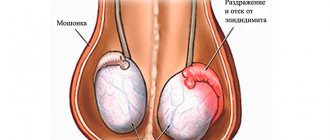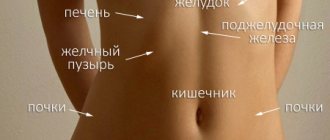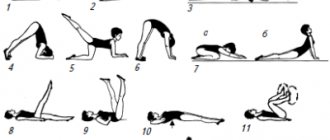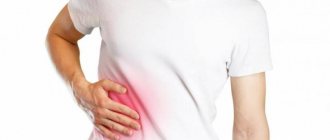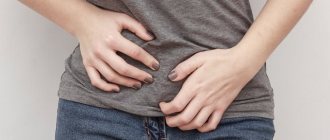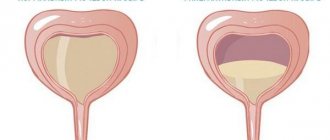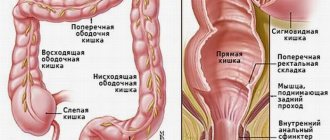Despite the fact that men have abdominal pain much less often than women, these manifestations cannot be ignored.
Pain in the lower abdomen in men is an alarming symptom in many pathologies of the genitourinary system, digestive tract or musculoskeletal system.
Unfortunately, most representatives of the stronger sex tend to ignore unpleasant sensations in the lower parts of the abdominal cavity, thereby contributing to the aggravation of pathological conditions or the transition of ailments to chronic forms.
Causes of pain
In cases where pain is localized in the lower abdomen, a man should suspect diseases such as:
- inflammatory process of the urinary system, in particular the bladder and kidney parenchyma;
- urolithiasis and renal colic provoked by it;
- prostatitis;
- inflammation of the testicles and their appendages;
- appendicitis;
- intestinal diverticulitis;
- hernia formation;
- intestinal obstruction;
- ulceration of the colon, which develops against the background of poor nutrition;
- acute urinary retention;
- benign tumors and malignant neoplasms of the male genitourinary organs.
According to statistical studies, in 60% of clinical cases, the cause of pain in men in the lower abdomen is problems with the genitourinary system, namely prostatitis and cystitis. These illnesses can have very serious consequences, so they should not be ignored.
It is important to remember that pain appears so simply and always accompanies a complex pathological process. Therefore, if pain occurs, a man needs to consult a urologist and surgeon.
Why does the lower abdomen on the right hurt?
The nature of the pain can be varied. It is impossible to establish an accurate diagnosis. That is why patients are prescribed a comprehensive examination.
Prostatitis
This is a disease that occurs against the background of inflammation of the prostate tissue. The pain is nagging in nature. In the early stages they are not intense, but over time they intensify and become permanent.
There are chronic and acute forms of prostatitis.
The main symptoms are impaired potency and urination.
Pathology occurs as a result of age-related changes, stagnation of blood in the organs of the reproductive system, and pelvic injuries. Treatment is carried out in accordance with the cause of prostatitis.
Appendicitis
The appendix is a small extension of the intestine. When it is inflamed, pain occurs in the lower abdomen and is localized on the right side. It is always acute and can be accompanied by nausea and vomiting. Intensifies when pressing on the right side. An increase in body temperature is also observed.
The patient requires urgent surgery. This is due to the fact that when the appendix ruptures, sepsis and peritonitis develop. Complications lead to death.
How to distinguish appendicitis from other diseases in the following video:
Gallbladder dysfunction
Pain on the right side of the lower abdomen may indicate gallbladder dysfunction. They radiate to the back, under the shoulder blade, to the right side, and are permanent.
Among the pathologies of the gallbladder are:
- Cholelithiasis. Characterized by the formation of solid inclusions in the gallbladder. The pain is paroxysmal in nature, radiating to the shoulder and right hypochondrium.
- Cholecystitis. Accompanied by disruption of the digestive process. This is due to the lack of a sufficient amount of bile entering the duodenum.
- Cholangitis. It occurs against the background of inflammation of the ducts of the organ, which occurs as a result of their blockage. The pain is cramping in nature and is localized in the right hypochondrium.
Diseases require careful diagnosis and immediate treatment.
Lack of therapy leads to serious complications.
To establish the exact cause, a comprehensive diagnosis is prescribed. Only after receiving and studying the results, the doctor prescribes the necessary course of treatment.
Nonspecific ulcerative colitis
Pain on the right side in men can also occur as a result of inflammation of the colon mucosa. In this case, ulcers begin to form on the surface of the organ, which is accompanied by severe symptoms.
The pain syndrome is paroxysmal in nature, accompanied by internal bleeding and indigestion.
Localized in the area of intestinal damage, mainly on the right side. Experts have not yet fully established what is the true cause of the development of ulcerative colitis.
Diverticulosis
It manifests itself as the formation of a diverticulum on the walls of the colon. They are pockets. But pain manifests itself when the inflammatory process begins.
The causes of the disease are a sedentary lifestyle, obesity and excess weight, and poor nutrition.
Associated symptoms include bloating, a feeling of heaviness, stool disturbances and intestinal upset.
Treatment is carried out by adjusting the diet and changing lifestyle. It is important to completely stop smoking and drinking alcohol.
Nephrolithiasis
The disease occurs against the background of kidney damage, resulting in the formation of stones in the organs. The causes of development include poor nutrition, lack of fluid, sedentary lifestyle, and genetic predisposition.
In the early stages there may be no signs. But over time, nausea and vomiting appear. Blood impurities appear in the urine, and the pain is paroxysmal in nature and is localized in the lower abdomen on the right side, in the lumbar region and radiates to the groin.
Lack of therapy leads to severe renal failure.
Intestinal obstruction
Many men, when experiencing pain in the lower abdomen, are concerned about what it could be. One of the causes of this unpleasant symptom is intestinal obstruction.
Pain occurs when the intestinal passage is partially or completely blocked. At the same time, it radiates to the right hypochondrium, accompanied by nausea and vomiting.
The causes of the disease are poor nutrition, the presence of tumors of various types, stones in the bladder, and adhesions.
Patients require immediate treatment, as ignoring symptoms is fatal.
Inguinal hernia
The pathology is one of the most common among male patients. An inguinal hernia begins to form mainly in adolescence.
A feature of the disease is a long asymptomatic period. But over time, pain occurs in the groin area and radiates to the testicle.
Treatment is carried out comprehensively. But wearing fixing bandages and special bandages for a hernia at an older age is not prescribed, as this does not give results.
Cancer
The most dangerous disease, which manifests itself in the form of pain on the right side of the lower abdomen, is colorectal cancer. It often begins to form from polyps. These are benign growths that arise as a result of uncontrolled division of epithelial cells.
Under the influence of unfavorable factors, they transform into cancer.
Colorectal cancer
When polyps reach significant sizes, painful sensations occur. Over time, signs such as weakness, constant fatigue, impaired urination, and decreased potency appear.
But cancer in the early stages can occur without symptoms, especially if the tumor is small. The presence of a malignant tumor is also indicated by pain during bowel movements, bleeding from the anus, constipation, nausea, and vomiting.
Feces change color and contain mucus and blood clots. In the final stages, internal bleeding may occur.
Treatment is carried out depending on the stage of cancer pathology. Complex therapy is often used, including chemotherapy, radiation therapy and surgery.
Lack of treatment for a cancer tumor leads to the spread of metastatic lesions, disruption of the functioning of other organs and death.
Cancer is the most serious disease. That is why, when symptoms appear, it is important to promptly consult a doctor who will tell you what to do. Delay may result in a poor prognosis.
What does the location of pain indicate?
Pain in the abdomen in men can occur in its left or right sections, and can also be localized in its lower center area.
This criterion is one of the main diagnostic factors, which allows the specialist to suggest the probable location of the lesion, the cause of the development of the pathological symptom and decide on the choice of further diagnostic and therapeutic tactics.
Injuries to the rectum during intimacy
Sharp pain in the lower abdomen can result from damage to the rectum as a result of aggressive anal sex. This is true both for men who have sex with other men and for those who use anal stimulators and prostate massagers.
The reason for the occurrence of sharp pain in the lower abdomen during and after sexual intercourse may be:
- Disproportionately large size of the partner's penis or partner's strap-on.
- Large dimensions and non-standard shapes of the penile prosthesis and prostate simulator.
- Insufficient lubrication.
- Fast speed of movements.
As a rule, discomfort goes away immediately after sexual activity. But if the pain in the lower abdomen becomes more and more intense, blood is released from the anus and general health rapidly deteriorates, then you should call an ambulance as soon as possible, because these may be the first signs of a rupture of the rectum.
Whatever the reasons for the appearance of sharp abdominal pain in men, modern medicine can completely cope with this problem. Take care of yourself and your health.
Pain in the lower abdomen, right abdomen or left abdomen, if it is stabbing in nature, can be the cause of the development of many types of diseases of the human genitourinary system, its reproductive system and many others.
Sharp pain in the lower abdomen, as during menstruation, often indicates the development of various gynecological diseases in a woman. Such gynecological diseases are often asymptomatic during the period of their formation, and only after their development, the gynecological disease begins to manifest itself in the form of sharp stabbing pain in the lower abdomen, sometimes accompanied by other symptoms. With gynecological diseases, pain in the lower abdomen can be acute, cramping, throbbing, stabbing, dull, cutting, aching, both on the right and left sides of the abdomen. But further we will only consider the stabbing pain in the lower abdomen on the right, in the middle or on the left.
Why does it hurt on the left?
Such pains are, as a rule, a signal of inflammation of internal organs, including the transverse colon and sigmoid colon, genital organs, left kidney and ureter.
On the other hand, such painful sensations can be a manifestation of a hernia, arise as a result of tumor growth, or simply indicate that a man has taken rough food the day before.
Pain in the lower left abdomen is a specific symptom of varicocele, which develops against the background of dilation of the veins of the left spermatic cord.
In this case, only surgical correction of the defect will help save the testicle. Sometimes pain in men on the left side of the abdomen occurs after intense training.
If you experience pain after training, experts recommend stopping physical activity and resting. The pain will either subside or get worse. In the latter option, the patient must be immediately taken to the department of the medical institution or a medical team must be called.
Causes of pain
Left-sided discomfort in the side of men in the lower abdomen can be caused by disturbances in the functioning of two systems: the gastrointestinal and genitourinary.
What abnormalities can cause pain?
- pancreatic dysfunction.
The organ is located in the upper abdomen and takes part in digestion, producing enzymes and pancreatic juice necessary for the process of breaking down food.
Accompanied by diarrhea, discomfort in the epigastric region and increased body temperature.
Other reasons that provoke pain may be a violation of the diet (eating dry food, fatty and spicy foods, overeating), abuse of drinks containing ethyl alcohol, as well as taking medications that have a detrimental effect on the body;
If a man’s left side hurts in the lower abdomen, this may indicate the presence of diseases such as enterocolitis, diverticulosis, colitis, including ulcerative colitis, and Crohn’s disease.
Damage to the organ mucosa is revealed by corresponding symptoms: stool disorders, the presence of mucus or blood in the stool, changes in the consistency of feces, flatulence and bloating.
Penetration of parasites and pathogenic bacteria can also become a favorable factor for the development of pain;
Causes unpleasant sensations in the lower abdomen: when a man’s appendix is inflamed, not only the right side, where the appendage of the cecum is located, hurts, but also the left side.
High body temperature, loss of strength, nausea, difficulty with bowel movements - the presence of these signs indicates the development of this disease;
- diaphragm hernia or muscle injury.
With such anomalies, discomfort occurs during movement, and the man’s left side in the lower abdomen hurts;
- problems in the functioning of the spleen, which is responsible for the formation of bile and blood cells, and is also involved in metabolism.
Deviations in the functioning of the organ lead to disruption of hematopoietic processes in the body and the development of anemia. Doctors can also diagnose mononucleosis : the disease affects the spleen, as a result of which it increases in size and changes its shape, becoming soft and loose.
One of the most common causes of unpleasant symptoms in the lower abdomen is gastritis. Inflammation of the organ mucosa manifests itself as aching or dull pain.
If the disease becomes acute, the pain intensifies and causes even more discomfort;
Damage to the prostate gland is observed in combination with pain in the anus, groin area and sacrum.
The disease develops as a result of a combination of the following factors: a sedentary lifestyle, a decrease in the body's defense mechanisms, excess body weight and a deficiency of male hormones.
In addition to pain, symptoms include increased body temperature, constipation, and problems with bowel movements.
What other diseases can this article cause?
Cystitis, nephrolithiasis, pyelonephritis and other pathologies of the bladder, kidneys, ureters and urethra often become catalysts for pain. In this case, the person susceptible to the disease feels colic in the kidneys, frequent urge to urinate, itching and burning in the genitals.
In some cases, a hernia can cause pain: the left side of the lower abdomen in men protrudes in the area of pathology formation, and swelling occurs.
Painful sensations on the right
The main cause of pain, which is localized in the right lower abdomen, is problems with the intestines.
According to statistical data, this symptom comes to the fore in almost all men admitted to the hospital with inflammation of the appendix of the ascending colon and lower ileum, as well as the cecum.
Also, pain in the right abdomen accompanies kidney disease on the affected side, tumors and ailments of the internal genital organs.
Abdominal pain on the right is a common symptom of surgical pathology. Therefore, you should not tolerate them, but immediately seek qualified medical help.
Stitching pain in the abdomen in women, pain during pregnancy, stabbing and cutting pain
The female body is one huge mystery. It keeps a lot of secrets and hides the symptoms of many diseases. Gynecological diseases most often occur without symptoms. In order to find out about their existence, as well as to prevent a possible disease, a woman needs regular examination by a gynecologist. It is highly not recommended to bring the condition to the point where sharp or stabbing pain appears in the lower abdomen on the left or right. Therefore, the best treatment for gynecological diseases that cause pain in the right or left lower abdomen is their prevention. And the prevention of abdominal pain is a periodic visit to a gynecologist. Therefore, you should not wait until the pain in the lower abdomen becomes a clear signal of problems with diseases of the woman’s internal organs.
No woman is immune from a wide variety of diseases associated with the genitourinary and reproductive systems. Most of them neglect their health. This is what they suffer from, which is why they bring the situation to a point where a sharp stabbing pain in the abdomen may appear. There is a widespread belief among girls and women that when engaging in promiscuous sex, it is enough to use only contraceptives, and regular visits to the doctor are not at all necessary. According to statistics, if a girl is regularly seen by her gynecologist, then the development and appearance of the disease can be avoided or prevented in time and without much difficulty, and then she will not have to endure discomfort and pain in the lower abdomen.
Most women always put off visiting the doctor until later. And they themselves heroically endure the pain. They endure until the pain becomes unbearable and interferes with everyday life.
Pain in the lower abdomen, left or right, is the very first sign that something is going wrong. This is a signal about the appearance of an infection and a malfunction of the woman’s reproductive organs. The pain can be completely different, it can be aching, cutting, stabbing in nature. The pain can overtake a woman unexpectedly and just as unexpectedly subside. Let's look at the stabbing pain in the lower abdomen in more detail.
What should you suspect?
Pulling, cutting, sometimes quite intense pain in the lower abdomen in men, which is accompanied by urinary retention and erectile dysfunction, and also spreads to the groin, scrotum and inner thigh area, most likely indicates the development of prostatitis.
An inflammatory process in the prostate gland occurs in every second patient after the age of 50, which is associated with the structural features of the male genital area.
Healthy prostate (left) and prostatitis (right)
Left without medical attention, acute prostatitis very quickly transforms into a chronic form of the disease.
An inflammatory process with a chronic course, despite its lethargy and relative secrecy of pathological symptoms, leads to the proliferation of gland tissue and the formation of adenoma - a benign prostate tumor. The adenoma increases in size over time, puts pressure on nearby organs, causes male impotence and serious problems with urination.
Prostatitis in men is one of the most common diseases leading to infertility and cancerous degeneration of the prostate gland.
Pain syndrome in the suprapubic region
This symptom is typical for the following pathologies.
Acute prostatitis and exacerbation of chronic prostatitis
The pain is usually stabbing and spreads to the perineum, groin and testicles; may radiate to the sacrum and anus. With the next exacerbation of this disease, the syndrome acquires a nagging character; its appearance can be provoked by drinking alcohol, overwork, or hypothermia.
In addition to enteralgia, other symptoms appear:
- pain in the abdomen when urinating;
- erectile dysfunction;
- urinary retention;
- frequent small hikes;
- erectile dysfunction.
Cystitis
This is called inflammation of the bladder. It is characterized by the following symptoms:
- pain when urinating, preventing the process of emptying the bladder from being completely completed;
- frequent urination;
- blood in urine;
- aching pain above the pubis;
- urine becomes cloudy;
- the temperature may rise;
- in severe cases, nausea and vomiting develop.
Bladder cancer
In the initial stages, this pathology does not manifest itself. As the pathology progresses, it becomes increasingly difficult to urinate, and blood appears in the urine. Further symptoms resemble cystitis: painful and frequent urination, pain in the lower back and abdomen. But the temperature here practically does not rise, and “No-shpa”, “Baralgin” or “Drotaverin”, which alleviate the condition of cystitis, do not solve problems with urination that arise due to deterioration in the outflow of urine. Learn more about the symptoms of bladder cancer.
BPH
At first, urination becomes more frequent, and the urge to go to the toilet begins to wake the man up at night. Increasing in size, the prostate gland impairs the flow of urine from the bladder to the urethra, which is accompanied by aching pain and pain when urinating, urinary retention and lumbodynia.
Stagnation of urine in the bladder leads to frequent infections - cystitis. If the infection spreads higher, pyelonephritis may even develop. Read more about the symptoms of prostate adenoma.
Prostate cancer
When the tumor reaches a fairly large size, or develops in the place where the urethra exits the bladder, the first symptoms appear. This:
- pain in the perineum;
- frequent desire to go “small”;
- blood not only in urine, but also in semen;
- "weak stream"
Later, with metastasis or tumor disintegration, the following occur:
- weakness;
- weight loss;
- malaise;
- heaviness in the chest;
- pain in the bones: hips, pelvis, spine;
- weight loss.
Vesiculitis
This is the name for inflammation of the seminal vesicles, a paired organ located near the prostate. The disease manifests itself:
- pain that radiates to the sacrum. It worsens with defecation or a full bladder;
- painful erection and ejaculation;
- blood in semen;
- difficulty urinating;
- malaise;
- possibly by the release of pus in urine or semen.
Classification of the main types of pain in men in the lower abdomen
Based on the nature of the pain, one can judge the type of disease, the reason for its development, or the course of the disease:
- sharp and sudden pain in the lower abdomen indicates an acute pathological process, for example, intestinal obstruction, blockage of the urinary tract, peritonitis;
- mild pain that develops gradually is characteristic of indolent diseases of the pelvic organs and lower abdominal cavity;
- throbbing and rhythmic pain is a sign of increased pressure in the hollow organs;
- painful sensations of moderate intensity, which are constant, accompany inflammatory processes in the organs of the lower abdomen.
Why can a man have pain in the left side of his lower abdomen?
Pain in the left lower abdomen in men is quite common and causes a lot of discomfort and unpleasant sensations. At the same time, a person cannot understand why it appeared and what it threatens. Usually, instead of consulting a doctor, the patient endlessly swallows painkillers, uses the advice of friends and relatives, and simply tries not to pay attention to his well-being. In the article you will find out which diseases are characterized by such a symptom, and which specialist should be consulted if the condition does not improve.
Such pain can be caused by a variety of reasons and can be either temporary health problems or symptoms of serious disorders. Patients' complaints about pulling in the lower abdomen are regularly encountered during medical examinations. Painful sensations vary in nature, duration, and intensity. In any case, you are unlikely to be able to accurately determine the cause of the disorder on your own, so it is better not to put off going to the clinic. Indeed, in the absence of therapy, the painful manifestations worsen, sooner or later you will still have to seek medical help, but the treatment will be much more difficult and more expensive.
How to confirm the diagnosis?
As a rule, several specialists work to make a diagnosis in a patient with pain in the lower abdomen, including a urologist, a surgeon and a gastroenterologist.
During the examination, they consistently establish the cause of the pain syndrome, based on:
- the patient’s complaints and his subjective feelings about the nature of the pain;
- medical history;
- data from an objective examination carried out by palpation of the abdomen, palpation of the prostate gland, etc.;
- results of laboratory and instrumental research methods, in particular urine and blood analysis, ultrasound diagnostics, radiography, CT and MRI, as well as, if necessary, biopsy of tumors.
Nervous pathologies↑
Often the pain is explained by pinching and subsequent inflammation of the sciatic nerve due to intervertebral hernia. First, the patient experiences pain in the lumbar region when walking, then in the lower abdomen, on the left or right side. In medicine, there is the term “cauda equina,” meaning forty nerve endings that stretch from the lumbar spine to the tailbone and are responsible for the innervation of the legs and organs located in the pelvis. Damage to these nerves manifests itself in pain in the lower abdomen, groin and perineum.
When is it necessary to seek medical help immediately?
Men can often experience pain in the lower abdomen, which is a signal that a person is developing an urgent pathological condition. In such cases, the patient needs to call a medical team.
Acute and unbearable pain in the lower abdomen usually accompanies surgical diseases, in particular acute appendicitis, diverticulitis, strangulated hernia, and intestinal obstruction.
Appendicitis
With appendicitis, pain is associated with inflammation of the appendix of the colon and occurs predominantly in the right parts of the abdominal cavity with irradiation to the right leg, scrotum, and gluteal area. The pain syndrome is accompanied by an increase in general body temperature, the development of symptoms of intoxication, nausea and occasional vomiting.
If you suspect appendicitis, you should immediately call an ambulance and under no circumstances take painkillers, as they will not reveal the clinical picture of the underlying disease and will complicate its diagnosis.
A pinched hernia and acute intestinal obstruction also require immediate response. Left without medical attention, these diseases lead to an increase in symptoms of local inflammation of the peritoneum, soft tissue necrosis, septic shock, and therefore, if surgical treatment is not provided in a timely manner, they can be fatal.
Pain syndrome on the lower left
When pain occurs in the lower abdomen of men, this may indicate the development of various pathologies, which we will consider.
Gastritis or gastroduodenitis
The inflamed stomach, usually located on the left under the ribs, can stretch and reach the lower abdomen, where it causes enteralgia. It is difficult to guess on your own (without the help of a gastroenterologist) that this particular section of the gastrointestinal tract is affected, but the following signs can be indicative:
- nausea;
- heartburn;
- pain when pressing in the area “under the pit of the stomach”.
Acute enlargement of the spleen
Although this hematopoietic organ, in which red blood cells are born and “die,” is located under the left rib, if its volume increases, pain occurs in the left side of the lower abdomen.
The reasons for the enlargement of the spleen are either inflammation or a decrease in the lumen of the venous vessels through which blood flows from this organ.
Symptoms of this condition include:
- enteralgia localized below and to the left;
- nausea, vomiting;
- increase in body temperature.
Splenic infarction
When the lumen of an artery or its branch is blocked (by a thrombus, atherosclerotic plaque, fat), which fed the spleen, part of the organ dies - a heart attack occurs. There are:
- sharp pain that descends from the left hypochondrium to the left lower abdomen;
- the intensity of the pain increases with deep breathing, coughing, and movement;
- heat.
Spleen abscess
The purulent process developing in the body can be complicated by the absorption of bacteria into the systemic bloodstream. Then they are distributed throughout the body and can form in one or another organ. An abscess (or several abscesses) can also form in the spleen.
- enteralgia in the left hypochondrium, which radiates to the left half of the chest and the left lower abdomen;
- increased temperature;
- increasing weakness;
- nausea, vomiting.
Volvulus of the spleen
This is a condition where there is torsion of the splenic artery. The reason for this may be either a congenital condition of the mesenteric ligaments, or an injury to the left hypochondrium.
Signs of splenic volvulus include:
- bloating;
- constipation;
- pain descends from the left hypochondrium to the lower abdomen, on the left;
- vomit;
- deterioration of condition.
Chronic myelo- and lymphocytic leukemia
These forms of blood cancer manifest themselves in the same way. This is pain in the left lower abdomen, which initially appears only after eating or when pressing on this area. As the tumor progresses, the intensity of enteralgia increases.
Crohn's disease
Specific intestinal inflammation manifests itself:
- pain in various parts of the abdomen, including the lower left;
- vomit;
- decreased appetite;
- diarrhea;
- fatigue;
- joint pain.
Similar symptoms are typical for periods of height. They are replaced by periods of remission, when pain, diarrhea and vomiting are not observed. Learn more about the symptoms of Crohn's disease.
Polyposis
If the descending sections of the large intestine or the sections of the small intestine lying on the left are often inflamed, polyps develop in them over time - peculiar mushroom-shaped growths of the mucous membrane that narrow the lumen of the intestinal tube and can become malignant. Read more about the symptoms of polyps in the intestines.
Nonspecific ulcerative colitis
This is a disease in which, for an unknown reason, the entire lining of the large intestine is affected (ulcers appear on it). It begins with the rectum, whose projection falls on the lower left zone of the abdomen. Further it affects higher-lying departments.
- increased temperature;
- tingling or tightening in the left lower abdomen - at the initial stage;
- bloating, especially pronounced in the lower abdomen;
- general weakness;
- diarrhea or constipation.
Atypical location of the inflamed appendix
The disease begins suddenly, sometimes with pain around the navel, which later moves to the left side. At first, enteralgia is moderate, then it increases more and more, becomes cramping, but can also be pulsating.
In addition, nausea appears, there may be 1-2 times of vomiting, and sometimes diarrhea, which is associated with irritation of the peritoneum, which envelops both the inflamed appendix and the stomach and intestines. Body temperature rises.
Diverticulitis
This is a disease in which the intestinal wall becomes a source of protrusions, similar to small hernias. This pathology develops most often in old age. May have no symptoms but show up on an x-ray with contrast taken for another reason. Also, diverticula, when inflamed, can cause enteralgia in any location, including in the left lower abdomen of a man. In addition, constipation and chills appear; the temperature rises.
Modern approaches to treatment
The choice of therapeutic tactics when a man develops pain in the lower abdomen depends on the data obtained during diagnosis.
Conservative treatment is indicated for patients in whom, during research, the diagnosis of prostatitis, inflammatory or spastic process in the intestines, inflammation of the bladder, etc. was confirmed.
Naturally, each of the listed diseases requires its own set of medications, the advisability of prescribing each of which falls on the shoulders of the attending physician.
Surgical elimination of pain, which is localized in the lower abdomen, is indicated for acute appendicitis, peritonitis, tumors, intestinal obstruction, etc. In most cases, it is performed immediately, immediately after confirmation of the surgical diagnosis.
Any pain in the lower abdomen should not be ignored by the patient, as it indicates the emergence of a complex pathological process.
Men's health: What to do if the left side in the lower abdomen hurts?
Not only women, but also the male part of the population are susceptible to pain in the left side of the lower abdomen. The disease indicates the development of diseases related to organs located in the pain zone.
What factors are favorable for the occurrence of pathology? And what should a man do to get rid of unpleasant symptoms?
Emergency measures for severe pain in the lower abdomen
With some symptoms, the man’s condition is considered urgent, requiring urgent intervention. These are:
- Tense abdomen and acute pain lasting more than an hour.
- The pain symptom increases significantly with coughing, movement, or any movement.
- Before the painful symptoms, there was difficulty defecating and bloating was observed.
- Black stool with blood clots.
- Along with pain, blood pressure decreases, heart rate increases, sweating and nausea appear.
Results
The cause of pain in men in the lower abdomen can be various diseases. To establish an accurate diagnosis, allowing you to begin adequate drug treatment, a full examination is required.
Pain of this type is in most cases associated with chronic inflammatory diseases of the male genital organs.
Reasons for concern among older men
In men of this age group, pain in the lower and lateral abdomen may be associated with inflammation of the prostate gland. The prostate belongs to the exocrine glands (secreting hormones through a duct), has a glandular structure consisting of tubular tissue and alveoli, and is responsible for the sexual and psycho-emotional health of a man.
Prostate inflammation
The prostate gland synthesizes seminal fluid, therefore, with any disturbance in its functioning, a man experiences a whole range of symptoms associated with sexual dysfunction . These include:
- premature ejaculation of seminal fluid during sexual intercourse;
- manifestations of erectile dysfunction;
- decreased sensitivity of erogenous zones;
- decreased sexual desire.
Decreased sexual desire in men
Inflammation of the prostate can be acute , occurring against the background of exposure to negative factors or as a result of infection with pathogenic bacteria, or chronic . Chronic prostatitis is diagnosed in approximately 37% of men over 40 years of age and is associated with hormonal changes occurring in the male body during this period. In younger men, low-grade inflammation can occur against the background of insufficient physical activity, leading to congestion in the vessels and arteries of the pelvis, obesity, abuse of alcoholic beverages, and spicy foods. Chronic infections of the pelvic organs can also contribute to chronic inflammation of the prostate, therefore one of the most important ways to prevent sexual disorders and prostate diseases is the timely treatment of any infectious diseases.
Prostate diseases
Features of pain syndrome and accompanying symptoms in chronic inflammation
If the patient has not received the necessary treatment for a long time, the disease develops into a latent chronic form, the only signs of which may be itching in the anus and aching, dull pain predominantly localized in the lower abdomen. A feature of prostatitis is the frequent irradiation and movement of pain to the sacral area, coccyx, lumbar spine, area above the pubic bone and groin. Stretching of the fibrous capsule that encloses the prostate gland can lead to increased pressure on the intestinal wall, so symptoms of prostatitis can also include frequent and painful urge to defecate, digestive disorders and constipation.
How does chronic prostatitis manifest in men?
Nature of pain during exacerbation
Exacerbation of the inflammatory process is always accompanied by vivid clinical symptoms, so there are usually no difficulties with diagnosis. Acute prostatitis is always accompanied by sharp pain in the lower abdomen, increased body temperature, and general intoxication of the body. The patient feels weakness, loss of strength, and his performance decreases. Typical signs of intoxication - nausea and vomiting - are usually absent, but if untreated, the patient may experience dyspeptic disorders within 2-3 days after the onset of the attack.
Acute prostatitis
Pain during an attack is usually of high intensity, radiating to the groin and lumbar area, rectum, which makes the process of defecation and urination painful. Other signs depend on the form of inflammation, which can be catarrhal or purulent.
Table. Symptoms of catarrhal and purulent prostatitis.
| Symptom | Catarrhal prostatitis | Purulent prostatitis (with damage to the parenchyma) |
| Body temperature | Usually does not exceed the upper limit of low-grade fever (38°C). | It can rise to high levels (up to 40°C), and is difficult to control with medications. |
| Changes in urine | Urination is frequent and painless. The urine is cloudy, but there is no blood or pus in it. | Intense pain during urination or bowel movements, urine may contain cloudy sediment, blood streaks, purulent mucus or clots. |
| Pain intensity | Moderate. | Very high. |
Important! Treatment of any form of prostatitis includes taking antibiotics and anti-inflammatory drugs from the group of non-steroidal drugs. If they are ineffective or if inflammation is severe, accompanied by severe swelling of the prostate, glucocorticoid hormones are used.
At the doctor
Prostate pathologies
Prostatitis
The prostate gland (prostate) is an endocrine organ located deep in the pelvic cavity below the urethra.
Its main function is to produce secretions during ejaculation. Acute or chronic inflammation of this gland, called prostatitis, is considered the most common cause of pain in the lower abdomen in men.
Prostatitis develops due to the activation of opportunistic microflora (Escherichia coli, staphylococci), which enter the gland from other organs through the blood or ascending from the bladder.
As a rule, the onset of the disease is associated not only with infection.
The formation of pathology is influenced by many unfavorable factors, which include:
- hypothermia;
- weakened immunity;
- passive lifestyle;
- alcohol abuse;
- sexual problems and so on.
Pain syndrome with prostatitis is expressed in acute bursting or dull aching (in the chronic form) sensations in the perineal area. Due to the fact that the gland is in close contact with the bladder and intestines, pain usually radiates to the center of the suprapubic area, the external genitalia and the anus. The intensity of discomfort depends on the stage of the disease and its type. In any case, it is permanent and intensifies when the intestines or bladder are full.
Associated symptoms:
- frequent (sometimes painful) urination;
- diarrhea with painful urges;
- sexual dysfunction;
- temperature increase.
The symptoms of chronic prostatitis, which occurs as a result of insufficient treatment of the acute form and suppression of the immune system, are less pronounced.
The main directions of treatment for inflammation are taking antibiotics, anti-inflammatory drugs, immunostimulants and other drugs.
Cystitis in men can occur against the background of kidney stones, as well as in the presence of STIs. How to treat cystitis in men: features of therapy for chronic and acute forms of the disease.
Read about how to treat cystitis at home and whether it is safe.
Burning after urination can bother both men and women, but the causes of the pathology can be different. In this article https://mkb2.ru/tsistit-i-mochevoy-puzyir/vidy-cistita/zhzhenie-posle-mocheispuskaniya.html you will learn what diseases this symptom may indicate.
Neoplasms
Chronic prostatitis is one of the factors that increases the risk of the formation of benign (adenomas) or cancerous tumors in the prostate gland. Most often they are diagnosed in men over 40-50 years old. As the tumor grows, symptoms such as:
- Pain in the suprapubic region, radiating to the sacrum and penis, which eventually becomes encircling.
- Frequent urination during the day and at night.
- Weakening of the stream, a feeling of incomplete emptying of the bladder, and subsequently – urinary incontinence.
BPH
Adenoma develops slowly and evenly, without spreading to nearby organs. Cancer cells are very aggressive - they can grow into the intestines, bladder, lymph nodes and give distant metastases.
Benign formations are treated with medications: alpha blockers, which relax the prostate muscles, as well as reductase inhibitors, which reduce the rate of tissue growth. In some cases, surgery is performed. For cancer, the prostate is removed and chemotherapy is used.
The signs of prostate pathologies are very similar. Only a doctor can distinguish prostatitis from cancer, which can be successfully treated only in the early stages.
Causes
In order to determine what is causing the pain, it is necessary to determine exactly where it is located. The spleen and pancreas are located on the left side of the abdomen. Perhaps it is precisely the malfunctions in their work that cause the pain. The left side of the lower abdomen in men can also be bothersome when the diaphragm is affected.
Experts identify the following causes of pain in this part, which are most often diagnosed in patients:
- Irritable bowel syndrome;
- Enlargement of the renal pelvis;
- Ulcerative colitis;
- Intestinal obstruction;
- Splenic infarction;
- Volvulus.
It is necessary to pay very close attention to situations where there is a nagging pain in the lower left abdomen in men. This symptom may indicate serious damage to internal organs. The reasons for this pain may be the following:
- purulent pathologies of the pelvic organs;
- inflammation of the scrotum;
- strangulated inguinal hernia;
- inflammation of the external genitalia;
- groin sprain.
Diagnosis of pain in men
Early detection of the disease will help to cope with it faster and easier. First of all, you should make an appointment with a surgeon. At the first appointment, the specialist will interview the patient and also examine him. In order to find pathologies, modern methods of diagnosing pain in men are used.
Basic methods for diagnosing pain in the lower abdomen on the left in men
| Diagnostic technique | Time | Accuracy |
| Blood analysis | 10 minutes | 80-95% |
| Analysis of urine | 5 minutes | 60-80% |
| Abdominal ultrasound | 30 minutes | 40-60% |
| X-ray of abdominal organs | 10 minutes | 50-60% |
Based on the data obtained, the doctor will be able to make a preliminary diagnosis. A comprehensive examination will allow the doctor to accurately diagnose the problem, assess the extent of its prevalence, the nature and speed of development.
It is not recommended to take painkillers before seeing a doctor, as this may prevent the doctor from quickly identifying the problem. You should not try to cope with the pain on your own, as this can lead to complications that are much more difficult to cope with.
Source: zdorov.online
How to diagnose
Diagnosis of pain in the left side of the lower abdomen in a man is carried out using the following methods:
- Analysis of urine. The study reveals the presence or absence of diabetes, kidney stones, ureteral and bladder infections in the patient;
- endoscopy. Determines the cause of discomfort;
- X-ray of the abdomen. Allows you to detect signs of pathological processes in the stomach and disorders of its motor function;
- Ultrasound. Helps determine whether a man has kidney or gallstones;
- Magnetic resonance imaging of the stomach. Detects diseases associated with the gastrointestinal tract in the early stages.
In order not to aggravate the condition and to recognize the disease at the initial stage, if pain appears in the left side in the lower abdomen, a man should seek help from a specialist or, if his health does not allow it, call emergency help at home.
You should not self-medicate; it is better to entrust your health to professionals.
Source: gastroved.com
Appendicitis
Appendicitis is one of the most common causes of lower abdominal pain in men. The appendix, or appendix, is a small, thin tube that extends from the main intestine where the large and small intestines meet. When the appendix becomes inflamed, the condition is called appendicitis. Inflammation of the appendix is a common cause of pain localized in the right lower abdomen.
Other symptoms of appendicitis may include:
- nausea;
- vomit;
- fever;
- diarrhea;
- constipation;
- bloating;
- poor appetite.
This condition requires immediate medical attention. Therefore, if you experience these symptoms, you should immediately consult a doctor. Once your doctor diagnoses the condition, he will either send you home with a treatment plan, or you will be admitted to the hospital for further observation.
Your doctor can determine whether you need surgery to remove your appendix (appendectomy) to prevent the organ from rupturing and other serious complications. If your appendicitis is severe, your doctor may prescribe immediate removal of the inflamed section of intestine.
If you are experiencing symptoms of appendicitis, you should not take enemas or laxatives as they may cause your appendix to rupture. It is best to avoid any medications unless prescribed by your doctor as part of your treatment plan.
What is in the left lower abdomen of men?
Often, the development of pain on the left in the lower zone of the peritoneum indicates the presence of diseases of the organs located in it. The table shows the organs located in men below the navel on the left and their functions.
| Organ name | Localization | Main functions |
| Bladder | Centered | Urine accumulation |
| Ureters | Attached to the bladder on both sides | They bring urine |
| Detrusor muscle | Lower part of the bladder | Responsible for the condition of urinary retention during spasm or incontinence as a result of atony |
| Sang small intestine | Attached to the bladder | Responsible for the absorption of nutrients |
| Colon | On the right in the suprapubic area | Absorption of fluid, formation of feces, control of bowel movements |
| Appendix | Lower right abdomen | Synthesis of secretions to enhance intestinal motility, participation in the digestive process, production of antibodies, as well as immunoglobulins, helping beneficial bacteria in the fight against rotting microorganisms |
| Prostate | In the pelvic cavity below the bladder | Seminal plasma production |
| Seminal vesicles | In the middle above the prostate | Production of secretion for the normal functioning of sperm |
To determine the root causes of pain, a complete examination of the genital organs is prescribed.
Diagnosis of pain
https://www.youtube.com/watch?v=ytpressru
A timely diagnosed disease is easier to treat. Therefore, if you have the slightest discomfort in the lower left abdomen, you should consult a doctor and not self-medicate. After all, pain can indicate serious illnesses that are dangerous due to their complications.
- Before visiting the clinic, it is not advisable to take painkillers so that the doctor can quickly determine the problem.
- First, the doctor interviews and examines the patient.
- To identify pathology, the following modern diagnostic methods are used:
- Blood analysis.
- Analysis of urine.
- Ultrasound of the abdominal cavity.
- X-ray examination of the peritoneal organs.
Based on the results of the study, the doctor is able to diagnose the disease and assess the degree of its development.
Most often, nagging pain below the navel indicates pathology of the intestines, reproductive organs or kidneys.
The cause of this disease is considered to be stressful situations.
Factors contributing to the development of the disease:
- lack of physical activity;
- non-compliance with the diet;
- lack of fiber in the food consumed;
- dysbacteriosis;
- hormonal pathologies.
In addition to pain, the disease is accompanied by the following symptoms:
- diarrhea or prolonged constipation;
- constant bloating;
- feeling of fullness in the intestines.
This condition usually does not pose serious threats to the body, however, it causes inconvenience to a person and can provoke the appearance of other pathologies.
Vesiculitis
Inflammation of the seminal vesicles is accompanied by sexual dysfunction.
The following symptoms are noted:
- pain in the groin area, which can radiate to the sacrum. Discomfort increases with bowel movements or with a full bladder;
- general malaise and fever;
- headache;
- delay or increased frequency of urination.
Semen examinations contain blood or purulent impurities.
Aching pain is usually caused by the following reasons:
- Hypothermia.
- Kidney pathologies.
- Impaired bowel function.
Sharp pain on the left in the lower part of the peritoneum usually develops during an acute inflammatory process.
Cystitis
The causes of the disease are considered to be the penetration of pathogenic microorganisms from the kidneys or urethra into the bladder.
Provoking factors are:
- hypothermia;
- hormonal disorders;
- decreased immunity;
- venous congestion in the pelvic area;
- injury to the lining of the bladder.
The disease occurs with the following symptoms:
- Slight increase in temperature.
- Severe pain during urination.
- Frequent urination.
- Constant feeling of incomplete emptying.
- Nausea.
- Vomiting rarely occurs.
Urine becomes cloudy due to the presence of purulent, blood and mucus impurities.
The disease develops as a result of an imbalance in the salt balance of urine.
Provoking factors are considered:
- poor nutrition and sedentary lifestyle;
- abuse of fatty, spicy, meat;
- chronic infectious diseases of the urinary and genital organs;
- congenital pathologies of the development of the kidneys and ureters;
- heredity.
Clinical signs of the disease:
- urinary retention;
- sharp pain that can radiate to the groin area;
- vomit.
After the movement of stones, blood may appear in the urine.
In addition, sharp and aching pains can indicate pathologies of the pancreas or prostate gland.
Stitching pains
https://www.youtube.com/watch?v=ytcopyrightru
This discomfort usually occurs with inflammation of the large intestine. The cause of the disease is believed to be the abuse of spices. In this case, bloating is observed. Sticking to a diet will help you recover from pathology.
If the temperature rises and vomiting occurs, it is recommended to call an ambulance, since this condition may indicate the development of a pathology requiring urgent surgery.
Acute pain always signals the development of serious problems with the intestines or genitourinary organs. Typically, these pathologies are accompanied by bleeding, fever and even shock. If acute pain occurs below the navel on the left, you should immediately call an ambulance. It is prohibited to take medications before the doctors arrive.
A dull ache usually accompanies irritable bowel syndrome.
Prostatitis
There are acute and chronic forms of the disease.
The main reasons for the formation of the disease:
- Infectious: entry into tissues of fungi, viruses or bacteria.
- Non-infectious: impaired secretion outflow, hypothermia, decreased immunity.
Manifestations of the disease:
- dull painful sensations radiating to the sacrum, anus or scrotum;
- urinary retention;
- headache;
- burning sensation in the urethra when urinating;
- causeless fatigue;
- decreased erection;
- slight increase in temperature;
- constipation;
- pain during bowel movements.
Sperm examinations reveal a violation of its composition.
In addition, discomfort in the lower left peritoneum may occur due to diseases of the gallbladder or pancreas.
Such pain is characteristic of intestinal pathologies. In addition, the appearance of constipation or unnatural-looking stools is noted.
Cramping pain occurs with infections in the genitourinary system. Throbbing pain is usually associated with intestinal obstruction and malignant neoplasms.
Prostate cancer
Usually diagnosed in men suffering from adenoma, prostatitis and chronic inflammation of the genitourinary system.
Provoking factors:
- elderly age;
- heredity;
- hormonal disorders;
- progression of adenoma.
The main signs of the disease in the early stages of development:
- Frequent urge to urinate.
- Interruption of urination, weak stream.
Later, when cancer metastasizes, the following symptoms are noted:
- weakness;
- pain in the spine;
- sudden weight loss.
In addition, there is a stabbing pain in the sternum.
- An illness of unknown nature occurs with damage to the lining of the large intestine.
- Factors contributing to the development of pathology are:
- nicotine intoxication;
- heredity;
- influence of antibiotics;
- reduced immunity.
The patient suffers from painful cramping sensations that intensify after eating.
In addition, the disease is accompanied by:
- frequent loose stools;
- decreased appetite;
- sudden weight loss;
- increased temperature;
- intestinal bleeding.
Blood, purulent or mucous impurities may appear in the feces.
If men experience pain in the lower left abdomen, they should consult a doctor to determine the root causes of their development. Most often, discomfort accompanies pathologies of the genitourinary system or malignant neoplasms. Constant pain indicates chronic diseases of the pelvic organs. Lack of timely treatment can lead to the development of dangerous complications.
https://www.youtube.com/watch?v=ytcreatorsru
Pain in the left lower abdomen in men is quite common and causes a lot of discomfort and unpleasant sensations. At the same time, a person cannot understand why it appeared and what it threatens.
Usually, instead of consulting a doctor, the patient endlessly swallows painkillers, uses the advice of friends and relatives, and simply tries not to pay attention to his well-being.
In the article you will find out which diseases are characterized by such a symptom, and which specialist should be consulted if the condition does not improve.
Such pain can be caused by a variety of reasons and can be either temporary health problems or symptoms of serious disorders. Patients' complaints about pulling in the lower abdomen are regularly encountered during medical examinations. Painful sensations vary in nature, duration, and intensity.
In any case, you are unlikely to be able to accurately determine the cause of the disorder on your own, so it is better not to put off going to the clinic.
Indeed, in the absence of therapy, the painful manifestations worsen, sooner or later you will still have to seek medical help, but the treatment will be much more difficult and more expensive.
If treatment is ignored, many patients experience problems such as impotence, high blood pressure and strong changes in their psycho-emotional state.
How to be treated if there is deception everywhere? Journalist Sheinin conducted his investigation. In this article, he discovered a drug that gave significant results in the treatment of prostatitis and the restoration of erectile dysfunction - this is Urotrin.
Pain in the lower abdomen can be of this nature:
- Aching - most often occurs with diseases of the intestines and kidneys. It can be caused by a common intestinal disorder as a result of eating low-quality foods, too spicy, fatty foods. Kidney inflammation, which is characterized by similar symptoms, does not tolerate self-medication, and only a specialist can make an accurate diagnosis after conducting a series of tests and examinations. Please note that taking painkillers is also undesirable, since in this case the picture of the pathology is blurred.
- Stitching - usually caused by an inflammatory process in the large intestine, resulting from eating difficult-to-digest foods seasoned with a lot of spices. It is also caused by inflammation of the genitourinary system.
- Drawing - nagging pain in the lower abdomen is a symptom of an inflammatory process in the genitourinary organs, kidney disease or intestinal dysfunction.
- Acute - signals an acute form of infectious diseases of the reproductive organs, renal colic, problems with the digestive system. Often accompanied by other painful symptoms: bleeding, vomiting, blood in the urine, fainting. In case of a serious condition of the patient, you must immediately call an ambulance.
- Cutting - most often appears with intestinal diseases, but is also noted with prostatitis and urolithiasis.
- Dull - occurs with chronic genitourinary infections, intestinal disorders, pathologies of the pancreas and gall bladder.
Other common causes
The conditions listed below are the most common reasons why you may experience pain localized in the lower abdomen. Discomfort can be felt on one side - left or right, or in the center or along the entire surface of the lower abdomen.
Increased gas formation in the intestines
Intestinal gas is air that can be found throughout the digestive tract. Its formation is often caused by food that is not completely broken down until it reaches your colon.
The more undigested food is present, the more gas the intestines produce. As the gas builds up, it can cause pain, bloating, and a tight, heavy feeling in your abdomen. Burping and passing gas usually provides temporary relief. In fact, it is typical for a person to expel gas up to 20 times a day. However, excessive intestinal gas may be a sign of a digestive disorder such as diabetes or lactose intolerance.
Other causes for intestinal gas include:
- swallowing more air than usual;
- binge eating;
- chewing gum;
- smoking.
Stomach upset (dyspepsia) usually develops after you eat or drink poor quality foods. The pain usually occurs in the upper abdomen, although it can be felt lower.
Symptoms of dyspepsia also include:
- heartburn;
- bloating
- decreased appetite and early satiety;
- feeling of discomfort;
- belching;
- formation of gases;
- reflux of stomach contents back into the oral cavity.
Mild stomach upset goes away fairly quickly and can be treated without a prescription. But if symptoms persist for more than two weeks, you should see a doctor to rule out serious digestive tract illnesses.
Hernia
A hernia occurs when a body part or internal organ pushes through the tissue or muscle that is holding it in place. There are several types of hernias, most of which occur in the abdominal cavity. Each type can cause pain or discomfort in the affected organ.
Other common hernia symptoms include:
- swelling or bulging at the site of the formed hernia;
- soreness;
- pain when lifting heavy objects, laughing, crying, coughing, or straining;
- dull, prolonged pain;
- feeling of being full or constipated.
Kidney infection
A kidney infection can be caused by bacteria that usually come from the bladder, ureters, or urethra. The infection may affect one or both kidneys. Although pain may be felt in the lower abdomen, discomfort from a kidney infection is more common in the back, sides, or groin.
Other symptoms include:
- fever;
- chills;
- nausea;
- vomiting;
- frequent urination;
- feeling the need to urinate even if you have recently emptied your bladder;
- pain or burning when urinating;
- pus or blood in the urine;
- cloudiness and strong odor of urine.
If left untreated, kidney infections can cause irreparable complications. If you notice any of the listed symptoms, you should immediately consult a doctor.
Kidney stones are a hard accumulation of minerals and salts that form inside the kidneys. You may not feel any pain until the kidney stones begin to move or become lodged in the tube that connects your kidney to your bladder. When this happens, you will feel severe pain in your back and side, under your ribs, and in your lower abdomen and groin. The intensity and location of the pain may change as the kidney stone dislodges and moves through your urinary tract.
Other symptoms of kidney stones include:
- painful urination;
- change in urine color to pink, red, or brown;
- cloudiness and strong odor of urine;
- nausea;
- vomiting;
- feeling of constant need to urinate;
- frequent urination;
- fever and chills.
Irritable bowel syndrome
Irritable bowel syndrome (IBS) is a common chronic condition that affects the colon.
IBS causes:
- convulsions;
- bloating;
- gas formation;
- diarrhea;
- constipation;
- stomach ache;
- changes in bowel movements;
- mucus in stool.
Doctors don't know for sure what causes irritable bowel syndrome, although some factors have been identified. These include stronger than normal intestinal contractions and abnormalities in the nervous system of the digestive tract.
Inflammatory bowel diseases
Irritable bowel syndrome should not be confused with inflammatory bowel disease. The latter are a group of serious digestive disorders that cause changes in intestinal tissue and increase the risk of colorectal cancer.
They are the two most common causes of intestinal inflammation. Both chronic conditions cause inflammation in the digestive tract, which can lead to abdominal pain.
Intestinal inflammation can also cause:
- severe diarrhea;
- fatigue;
- weight loss;
- fever;
- blood in stool;
- decreased appetite;
Inflammatory bowel disease can lead to life-threatening complications if left untreated.





